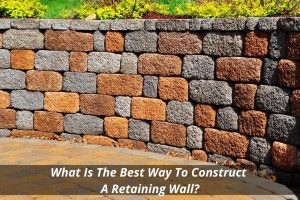Do you want to know what is the best way to construct a retaining wall? Construction walls are commonly found around homes and businesses across the country. Whether they’re meant to create privacy or provide protection from the elements, these barriers are essential features of our daily lives.
A retaining wall is basically a vertical barrier that helps stabilize soil along a property boundary. They come in many shapes and sizes and are often constructed using concrete, masonry blocks, Besser blocks…etc.
There are several ways to construct a retaining wall. This infographic illustrates seven common methods and their benefits.
There are two broad categories of retaining walls: those designed for internal use and those that are intended for external applications. Internal walls are typically used as part of building construction; most homeowners will have seen them before. Wall thicknesses are generally less than 2-3 inches and may be made of dry stone. In addition to being aesthetically pleasing, internal walls can also help prevent water damage to the interior of your home.
Exterior walls are more likely to be built with greater thicknesses(more than 3 inches) of material and incorporate drainage features such as gutters and downspouts. These walls usually function as protective barriers between landscaping areas and the outside environment.
The type of soil you’ll need to build your wall depends on where it will be located. For example, if this wall will be near an existing structure, it might require additional reinforcement such as rebar. If the wall will be adjacent to a slope, it will be important to consider how much water will drain off the top of it.
If you plan to put up a permanent wall that won’t move, you’ll probably want to make it wider than necessary. The reason for this is that when you dig out the foundation area for a new house, there’s often some dirt left over.
You can save yourself some time by just leaving this extra dirt at the bottom of each block so you don’t have to fill it back in again later. Also, because the wall isn’t going anywhere, it makes no sense to build it as wide as possible. A typical width for a foundation wall is about four feet from one side to the other.
Build Your Own Walls
Retaining walls can range from simple designs to elaborate ones. Some homeowners choose to simply plant flowers and shrubs along the perimeter of their garden edging. Others prefer to add intricate decorative details like pavers. Whatever your preference, the following information will help you lay the groundwork for creating a beautiful garden wall.
If you have ever been involved in any kind of construction project, you know that it really doesn’t take very long to set up a wall. One thing I found difficult was figuring out where to start.
There are actually a few good places to begin, depending on what sort of wall you’re trying to build. You should always work from the top down, starting with the footing and working downwards. That way, you’ll get the wall looking nice and stable immediately.
An earthbag system uses recycled tires filled with soil and rocks to form large, durable bags. Earthbags are quite popular since they can be easily installed, and are inexpensive to manufacture.
While many people think of retaining walls only as obstacles to keeping things contained within a property line, there are several benefits to having them around the yard. When you need to create a natural border or divide a lawn into separate areas, a garden wall is a great choice. They’re also useful if you want to contain plants inside a larger garden bed but don’t want to spend a lot of money on a fence.
This article aims to introduce you to the basics of using a concrete sleeper block retaining wall system. With a little practice, you too can erect a quality wall without hiring a professional. We hope this guide has helped you understand the key factors to consider when choosing a retaining wall system for your landscape design.
You should never drive a nail directly into the ground – instead, drill holes spaced every 2 inches (5 cm) and insert screws. This process ensures that the wall stays anchored firmly in the soil. You can also use wood spikes to secure the base to the ground.
When building a brick patio, remember that bricks must be placed on a level surface. If you notice uneven surfaces, you should first try to correct these spots before laying any bricks. In addition, bricks can become damaged if not properly prepared.
Soaking bricks in hot water helps loosen the mortar between the bricks, which allows you to remove any loose material. Once the dry sand and smooth away rough edges. Finally, apply one coat of paint to protect the new patio surface.
For most retaining walls, you want to avoid placing any materials directly against the foundation wall. The reason for this is that if the wall moves, it may cause damage to the foundation wall by pulling at the joints between the stones.
How do you determine how much force you need to install a retaining wall?
The best part about using reclaimed wood products is that they come with no added cost beyond the initial purchase price. However, some wood items will require extra maintenance so you would want to choose carefully. For example, reclaimed wood fences require regular repainting because their timber is exposed to the elements. Similarly, reclaimed wood siding requires additional staining to maintain its appearance.
Retaining walls are often used in conjunction with other landscaping features such as ponds, fountains, patios, and pools. These features help give your home a cohesive look and feel. Additionally, they serve practical purposes like keeping flowers and grass mowed and preventing erosion.
A garden wall can be a great way to add privacy to your backyard while still allowing light to pass through. It’s easy to set up, and you don’t even need special tools — just a hammer and screwdriver. To build a garden wall, dig a trench 6-8″ deep around each side of the property line. Next, fill the trenches with small rocks, gravel or pebbles.
Lay down 2 coats of exterior grade cement over the top layer, making sure to keep the sides of the trench intact. Use a trowel to spread the cement evenly across the area. Let the cement cure for 24 hours, then cover the entire area with plastic sheeting. Remove the plastic after two weeks and you’re ready to plant!
When you start planning out your dream yard, you might think of having a firepit for entertaining friends and family. But there’s another benefit to owning a fire pit: it creates a natural barrier between your deck and the rest of your yard.
That means fewer weeds, less work, and better-looking lawns. Now that you have the fire pit, you need to decide what type of seating you’d like to use and where you want to put it. You’ll also need to consider your budget.
There are many options available when it comes to fire pits, including concrete, metal, and stone. Here are three types of fire pits that you can buy today.
If you’re interested in a landscape project but aren’t sure where to start, read our guide to creating a beautiful front porch. We offer tips ranging from choosing plants to finding the right materials.
You may be wondering whether to build a fence around your house or a patio. The decision depends on several factors, including your personality, the location of your house, the style of your house and more.
Benefits of retaining wall blocks
Retaining wall products can be used for many purposes including landscaping, retaining soil, protecting buildings, creating terraces, and providing privacy. They can be built using many different materials, ranging from concrete block walls to stone veneer blocks.
There are different structural types of retaining walls, the most common type of retaining wall is the gravity wall. Gravity walls are made of poured concrete or stacked stone. They are generally inexpensive and easy to install. However, gravity walls tend to settle over time and require regular maintenance.
There are many benefits of retaining walls. For example, they can provide long-lasting beauty, help protect homes from flooding, and prevent erosion. Retaining walls are perfect for any outdoor space, such as patios, decks, gardens, and pools. They can also be used to separate properties and create privacy.

